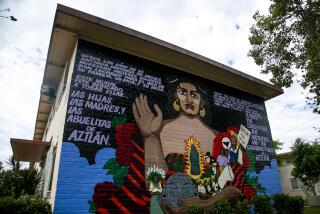Trying out indigenous languages
- Share via
The words come out in abrupt breaths, as if Felipe Lopez were whispering to the chalkboard.
“Rseidy. Rseidy,” he asks his students to repeat. “Learns.”
“And Dizh. Dizh, say it with me, is ‘language.’ ”
In unison, the students in the UCLA classroom follow, training their tongues to the rhythm of Zapotec, an ancient language that few people in Los Angeles have ever spoken or even heard. It comes from Oaxaca, on the southern tip of Mexico, a state known for its elaborate, historic traditions.
Many of the students — from La Puente, Redondo Beach, the San Gabriel Valley — have never traveled south to the Zapotec villages and probably never will.
Still, at UCLA and a few other universities, some are pushing aside French, Spanish and Chinese to try rarely offered indigenous Latin American languages such as Zapotec, Mixtec, Aymara and Quechua.
Some leap in for the adventure. Others want to get closer to their roots. History and anthropology students sometimes sign up for the sake of research. And then there are the doctors, social workers and teachers who hope to put what they learn to immediate practical use.
“Learning standard languages doesn’t help you understand the needs of regional areas,” said Ramona Perez, director of the Center for Latin American Studies at San Diego State University. “But indigenous languages show you all the diversity we have.”
The university began teaching Mixteco a decade ago. A few years later, it partnered with UC San Diego and started to offer first Zapotec, then Aymara, a language spoken in Bolivia, Peru and Chile.
Classes at San Diego State remain small; sometimes as few as half a dozen people show. When Angelina Torres was first asked to teach her native language, Mixteco, there, she scoffed at the idea. “Why would anyone want to learn Mixteco?” she thought to herself.
Growing up in Ixpantepec Nieves, a mountainous village in Oaxaca, she had seen anthropologists come and go, their notebooks full of words she couldn’t read. She didn’t understand why they would spend months studying her culture and history.
“That’s something we never had a chance to do ourselves,” she said. Instead, young people were encouraged to speak Spanish because Mixteco “had no future.”
When she arrived in California at 22, she abandoned her native languages altogether for English. It wasn’t until she agreed to teach at San Diego State that she began to take pride in her indigenous roots.
“Through the students, I’ve learned to value my culture, to know my identity,” Trujillo said.
In Los Angeles, Felipe Lopez also gradually shed his shame for Zapotec.
Many of the estimated 300,000 Oaxacans living in Los Angeles County are of Zapotec decent, he said. He wanted the language and the culture recognized as distinct, even in a sea of Spanish-speaking Mexicans.
Lopez now represents his countrymen living in the United States by serving as a liaison to the Oaxacan government. And he and two UCLA colleagues worked for eight years in the 1990s to write the first Zapotec, Spanish, English dictionary. The thick book defines 9,000 words in Zapotec, a language that is hardly ever written.
During class on a recent Tuesday morning, the small, soft-spoken man paced across the front of the class, stopping now and then to glance at a three-volume workbook he helped write for the course.
Fifteen students focused intently on his tone; the slightest mispronunciation can transform any Zapotec word, turning “flower” into “stone” and “wind” into “ant.”
Cheye-Ann Corona,a 23-year-old master’s student in urban planning and Latin American, studies took careful notes, paying particularly close attention to each point Lopez made about Zapotec culture, about its hierarchical structure and emphasis on respect and harmony. After graduating next summer, she plans to live in Oaxaca for a year or two to help indigenous groups organize for social change.
“I want to go down there and create a connection with the community, immerse myself in it,” Corona said.
Rebecca Dufendach, a history student, wrote down the Zapotec words for “cat” and “hat” — peppered with y’s and z’s and h’s — hoping they would one day help her tap into deeper meaning.
The 25-year-old from Gettysburg, Pa., intends to fly to Mexico soon to work on her doctorate, translating century-old colonial documents — deeds, birth certificates, court hearings — written in indigenous languages.
“It’s important to interpret their history from their point of view, not someone else’s,” she said.
Charly Tapia joined the Zapotec class with his own plans for the future. But they had nothing to do with academics. He was there to learn about his history and the history of his Zapotec grandfather.
Tapia remembers as a child visiting his grandparents in Puebla, Mexico, and hearing their tones rise and fall in their native language. Now and then, when a word sounded like Spanish, Tapia pretended to understand.
“One day I’d like to go back to his village, run into some relatives and be able to exchange of couple of words with them,” he said.
esmeralda.bermudez@latimes.com
More to Read
Sign up for Essential California
The most important California stories and recommendations in your inbox every morning.
You may occasionally receive promotional content from the Los Angeles Times.














